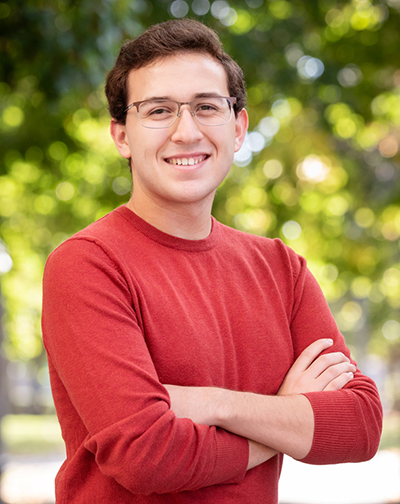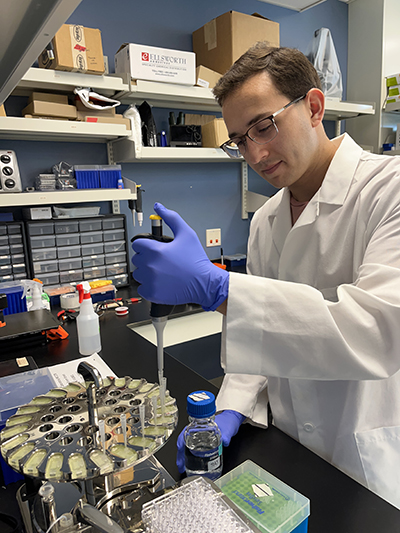
June 28, 2022
Efficient and affordable are not terms frequently associated with conducting large-scale transcriptional profiling research. 2022 SLAS Graduate Education Fellowship Grant recipient Benjamin David plans to fine tune the process to help the life sciences find new ways to explore combinatorial spaces within the genome.
Studying how the combination of stimuli lead to genome-wide transcriptional changes is a worthy quest for research, and it’s one that Benjamin David, a doctoral candidate at the University of Michigan, Ann Arbor (Ann Arbor, MI, USA), plans to scale up using artificial intelligence (AI).
To make large-scale transcriptional profiling more efficient and practical, David intends to explore the signals and stressors within a combinatorial space in a series of RNA-sequencing experiments, structured through statistical design and reinforcement learning (RL) – a method he refers to as “sequential” transcriptional profiling.

“Historically, most researchers do RNA-sequencing experiments at a small scale,” David explains, as he unpacks the process in his grant-winning proposal. “They determine one or two stimuli that they'd like to study, set up a single experiment, analyze the data and that's the end.” He refers to this strategy as “terminal” transcriptional profiling.
“I am interested in studying many different stimuli at once because it is more reflective of the complexity of biological systems,” he continues, adding that such a plan requires large-scale experimentation. “Examining the effects of only 10 stimuli in combination using the terminal analysis method would require thousands of RNA-seq profiles if a researcher collects all data and analyzes it at once. The experiment would explode in size,” he explains.
Instead, David proposes to make the multifactorial space manageable through iteration. Starting with a relatively small screening experiment, he will use the initial information to train models that suggest new experimental conditions to test. This process of gathering batches of conditions, testing them, and updating the models will be repeated to narrow the search space down to the most informative regions.
“I think this process will uncover factor interactions that improve the type of information we're getting from these experiments,” he says. “We don't have to explore the entire space, and we can narrow selections down to only the most interesting combinations. Our goal is to find compelling cellular responses that arise from complex interactions.
An RL agent, rather than a researcher, makes decisions about how to explore the design space. “RL agents take small steps that walk toward interesting or poorly characterized regions of the experimental space, updating their models after each step,” David explains. “In our approach, RL models steer future experiments and thus require fewer experiments before making beneficial predictions."
In subsequent experiments, David plans to examine the most informative factors at higher resolution to boost the number of experiments that characterize the most informative conditions in the design space. “Each round of transcriptional profiling will add to the information content of the models, giving them more predictive power per experiment over models made with the terminal approach,” he comments.
His first subject to study using the SLAS Graduate Education Fellowship Grant is the pathogenic bacterium Streptococcus mutans (S. mutans), to see how it responds to nutrient availability, pH, oxygen tension, temperature and antimicrobials. S. mutans lives only in the human oral cavity and is exposed to all of these stressors simultaneously. David’s research will use sequential transcriptional profiling to uncover how this bacterium mounts a multi-faceted response to combinations of these stressors.
Expanding the Knowledge Base
An eager, persistent student, David is not likely to “shelve” anything stored in his mind’s library – whether or not it immediately relates to his research. While he pursues pastimes that have nothing to do with his work, his hiking and backpacking adventures and the contents of his reading table frequently impact his research in ways he hadn’t anticipated. He has discovered leadership skills in a book written about an 80-year-old raid held in the Pacific during World War II, found a reset for his research creativity by being outdoors and even recalled formulas from an obscure agriculture course he took in high school.
He laughs about the high school course, sharing, “At the time, I recall being surprised at how sophisticated and scientific farming was. Then fast forward to a year ago – I found a use for it in my work. I was looking for a particular statistic to use in a project and it turned out there was a perfect analogy between my application, which had to do with DNA, and a formula that farmers use to irrigate their fields. It worked really well despite being unrelated to irrigation! Those random connections are fun to come across and they boost my creativity. I love when I find things that tie back into my work.”

David hopes his transcriptional profiling tool will open similar doors for the life sciences community and help develop a broader knowledge base in a shorter amount of time, using fewer researchers.
“There are 50 to 60 years and hundreds of labs-worth of research that have built up a knowledge base for an organism such as E. coli, for example,” he says. “A tool like this will speed up the process of gaining that knowledge on different and diverse organisms – such as S. mutans – so that it doesn't take as many years and resources,” David explains.
“Uncovering interesting aspects of biological diversity will also speed up the knowledge transfer between the research of different organisms,” he continues. “I think sequential transcriptional profiling will make experimentation more efficient and practical on a large scale.”
David’s advisor agrees. In the lab of Paul Jensen, Ph.D., which first started at the University of Illinois at Urbana-Champaign (UIUC, Urbana, IL, USA) and recently moved to UM, Ann Arbor, the team focuses on both the experimental and computational sides of automated science. Students train in a multidisciplinary environment, learning to apply AI techniques to solve large-scale biological problems.
“A lot of people think of AI as something you use to interpret data that already exists,” comments Jensen, an assistant professor in the Department of Biomedical Engineering. “Ben’s flipping that idea – he’s saying AI can help us collect new data by designing efficient experiments and better reagents. I think that’s quite innovative. It’s fun to see how AI helps us make better decisions before we go into the laboratory.”
Jensen says David is more than prepared to face challenges ahead. “Ben is a bioengineer by training, and his undergraduate degree focused on life sciences experiments. When he came to graduate school, he bravely decided to dive into the computational side of bioengineering. He’s really taken off,” says Jensen.
David comments that everything he learns in bioengineering makes him want to know more. "Having variety in thought and the tasks that I'm doing every single day helps to keep me refreshed and excited about doing this work. I am grateful to be in the right environment to develop skills and pursue my interests,” he says, adding, "People like Paul have given me opportunities to work in a lab and teach courses, which helped define my career goals. I hope one day to have a job like his.”
“Ben brings dual experience to his project,” Jensen continues. “He knows what makes a good experiment and how to translate that judgement into an algorithm. There are few people who can stand on both sides of the fence and connect experiments with computation.”
David’s work seemed a perfect fit with the SLAS grant. “The SLAS grant gives Ben freedom to pursue a wide range of applications and increases the impact of his work in this new, under-explored area. It’s tough to get traditional funding that covers this,” comments Jensen, whose lab has been involved with SLAS for a number of years, attending the SLAS International Conference and Exhibition, publishing in the SLAS Journals and participating in SLAS Applied Online Learning.
“Compared to other fellowship applications, you can dream big with SLAS. You can take chances, try the latest things and come up with big ideas when applying,” Jensen continues.
David agrees, adding that the SLAS grant offers intellectual independence to his research. “As I progress through this project, if I find an interesting aspect of the research, I have the freedom to pause and explore that new area,” he explains. “That wouldn't be possible with other types of grants tied to specific work. The SLAS grant offers freedom to explore all the interesting developments that happen along the way.”
The grant also comes attached to the SLAS membership’s immense knowledge base, David observes. “I am excited to meet people and exchange ideas with them about this tool and other research pursuits,” he says. “It's not feasible for me to set up large-scale experiments solo without fear of making mistakes from the sheer volume of things to accomplish. When I'm able to get more involved with SLAS, I’m certain to encounter a lot of great ideas for how to approach logistical issues.”
Sidelines
Learn More about the SLAS Graduate Education Fellowship Grant
The Gateway to the SLAS Hive! Apply Today for Tony B. Academic Travel Awards
